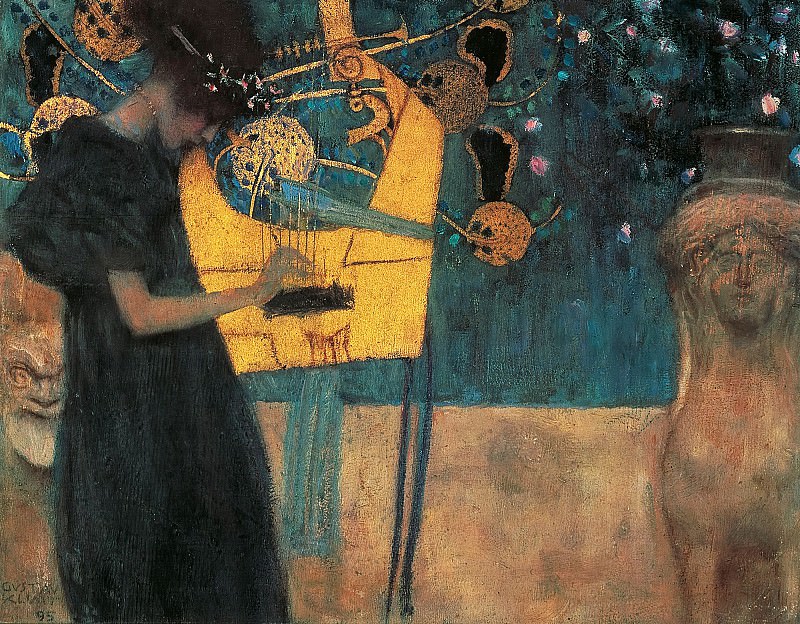Music I Gustav Klimt (1862-1918)
Gustav Klimt – Music I
Edit attribution
Download full size: 2000×1559 px (0,8 Mb)
Painter: Gustav Klimt
Location: New Pinakothek (Neue Pinakothek), Munich.
The idea of synthesizing the techniques of music, painting, and literature permeates all the creative practices of Symbolism, to which many artists of the turn-of-the-century era turned. The Austrian artist Gustav Klimt was not spared this fate, as in his paintings (Music in 1895, Beethoven’s Frieze cycle) one can clearly see his interest in art as a means of recreating and evolving the world. "Music" depicts a young Greek woman playing the lyre, in whose appearance one can guess the features of Klimt’s contemporary Viennese.
Description of Gustav Klimt’s painting Music
The idea of synthesizing the techniques of music, painting, and literature permeates all the creative practices of Symbolism, to which many artists of the turn-of-the-century era turned. The Austrian artist Gustav Klimt was not spared this fate, as in his paintings (Music in 1895, Beethoven’s Frieze cycle) one can clearly see his interest in art as a means of recreating and evolving the world.
"Music" depicts a young Greek woman playing the lyre, in whose appearance one can guess the features of Klimt’s contemporary Viennese. Contrast is the main compositional feature of this painting. This can be seen, for example, in the deliberate contrast between the dark-colored dress of the girl and the bright appearance of the instrument. In turn, the pictorial space where the Greek girl is depicted surrounded by her intricate patterns that resemble notes from afar, contrasts with the emphasized emptiness of the other plans. On either side are stone images of the fertility demon Silene and the Sphinx.
The image of the latter can be interpreted in different ways, for example, as an indication of the creative freedom of the artist. This statement was particularly close to Klimt. Both the stone statues and the lyre, a well-known symbol of the god Apollo, who patronized art, refer back to the era of antiquity. It is this era, according to the symbolists, that harbors undiscovered resources capable of renewing modern art, but this requires some new untried look at an era when human thought was still in its cradle. Perhaps this is what Klimt meant by specifically juxtaposing the modern and ancient worlds in the painting.
Despite the fact that Music is one of the artist’s earliest works, it already displays the features of Klimt’s mature manner: the use of two-dimensional space and a specific color palette. This creates an indescribable sense of the forbidden, unrealistic image, which is so attracted to the paintings of this artist.
Кому понравилось
Пожалуйста, подождите
На эту операцию может потребоваться несколько секунд.
Информация появится в новом окне,
если открытие новых окон не запрещено в настройках вашего браузера.
You need to login
Для работы с коллекциями – пожалуйста, войдите в аккаунт (open in new window).




















You cannot comment Why?
The painting evokes a sense of harmony and artistic inspiration. The lyre is a traditional symbol of music and poetry, often associated with Apollo, the Greek god of music and the arts. The presence of the muse-like figure reinforces this connection, suggesting that the music being played is divine or inspirational. The opulent use of gold can symbolize both the preciousness of art and its divine or spiritual quality. The dark, rich colors of the background create a mystical atmosphere, elevating the scene beyond the mundane. Klimts signature decorative patterns and stylized forms contribute to a sense of artificiality and symbolism, characteristic of the Art Nouveau movement, suggesting that the painting is not merely a literal representation but rather an allegorical exploration of the power and beauty of music.